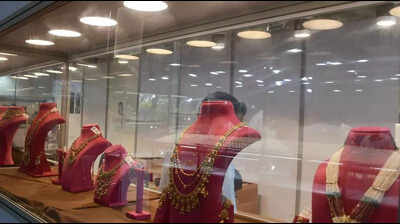Good news for exporters, jewellery hand carriage facilitation centre opened at Terminal 2 of Mumbai international airport | Mumbai News

[ad_1]
Mumbai: In a move set to significantly enhance India’s gem and jewellery export infrastructure, the Gem & Jewellery Export Promotion Council (GJEPC), in collaboration with Mumbai Customs, inaugurated the Jewellery Hand Carriage Facilitation Centre at Terminal 2 of Chhatrapati Shivaji Maharaj International Airport on Wednesday.Recognising the strategic importance of enabling seamless hand carriage, GJEPC secured and equipped a dedicated space at the airport. With the premises now officially notified as a customs area and Bharat Diamond Bourse appointed as custodian, the centre is fully operational, offering 24×7 services for jewellery hand carriage exports and imports.The launch of this dedicated facility follows a push by the GJEPC to address logistical and regulatory challenges associated with high-value, hand-carried gem and jewellery consignments. Mumbai, which accounts for nearly 65%–70% of India’s gem and jewellery exports, saw shipments worth $19.65 billion from the western region in 2024–25.Ashok Gajera, managing director of Laxmi Diamond, one of the largest export houses, said, “The new centre provides a single-window clearance system with integrated support from Mumbai Customs, CISF, police, and airport authorities. It will streamline high-value exports, reduce paperwork, and significantly cut turnaround time, offering exporters both transparency and operational ease.”Gajera explained that earlier when there were orders from clients, jewellery or samples would have to be exported, and the businessman would fly out later once the jewellery reached the destination. This, he said, was not only a “time-consuming affair” but also a “tedious one”.GJEPC chairman Kirit Bhansali said, “This milestone is part of the council’s wider commitment to ease of doing business. Alongside the e-commerce channel, hand carriage will prove vital for MSMEs and for high-value shipments, especially to FTA partner nations, such as UAE under CEPA, Australia under ECTA, and the UK. It’s faster, more cost-effective, and flexible — ideal for urgent global orders.”Personal carriage of jewellery for export is currently permitted at nine locations under India’s Foreign Trade Policy — Mumbai, Delhi, Kolkata, Chennai, Kochi, Coimbatore, Bengaluru, Hyderabad, and Jaipur. Imports are allowed at seven airports. However, fully operational hand carriage centres are presently available only in Delhi, Mumbai, Kolkata, and Jaipur. GJEPC noted that this facility is part of a broader rollout across nine Indian cities, in alignment with the govt’s thrust on improving export competitiveness and simplifying procedures. Mumbai: In a move set to significantly enhance India’s gem and jewellery export infrastructure, the Gem & Jewellery Export Promotion Council (GJEPC), in collaboration with Mumbai Customs, inaugurated the Jewellery Hand Carriage Facilitation Centre at Terminal 2 of Chhatrapati Shivaji Maharaj International Airport on Wednesday.Recognising the strategic importance of enabling seamless hand carriage, GJEPC secured and equipped a dedicated space at the airport. With the premises now officially notified as a customs area and Bharat Diamond Bourse appointed as custodian, the centre is fully operational, offering 24×7 services for jewellery hand carriage exports and imports.The launch of this dedicated facility follows a push by the GJEPC to address logistical and regulatory challenges associated with high-value, hand-carried gem and jewellery consignments. Mumbai, which accounts for nearly 65%–70% of India’s gem and jewellery exports, saw shipments worth $19.65 billion from the western region in 2024–25.Ashok Gajera, managing director of Laxmi Diamond, one of the largest export houses, said, “The new centre provides a single-window clearance system with integrated support from Mumbai Customs, CISF, police, and airport authorities. It will streamline high-value exports, reduce paperwork, and significantly cut turnaround time, offering exporters both transparency and operational ease.”Gajera explained that earlier when there were orders from clients, jewellery or samples would have to be exported, and the businessman would fly out later once the jewellery reached the destination. This, he said, was not only a “time-consuming affair” but also a “tedious one”.GJEPC chairman Kirit Bhansali said, “This milestone is part of the council’s wider commitment to ease of doing business. Alongside the e-commerce channel, hand carriage will prove vital for MSMEs and for high-value shipments, especially to FTA partner nations, such as UAE under CEPA, Australia under ECTA, and the UK. It’s faster, more cost-effective, and flexible — ideal for urgent global orders.”Personal carriage of jewellery for export is currently permitted at nine locations under India’s Foreign Trade Policy — Mumbai, Delhi, Kolkata, Chennai, Kochi, Coimbatore, Bengaluru, Hyderabad, and Jaipur. Imports are allowed at seven airports. However, fully operational hand carriage centres are presently available only in Delhi, Mumbai, Kolkata, and Jaipur. GJEPC noted that this facility is part of a broader rollout across nine Indian cities, in alignment with the govt’s thrust on improving export competitiveness and simplifying procedures.
[ad_2]
Source link






